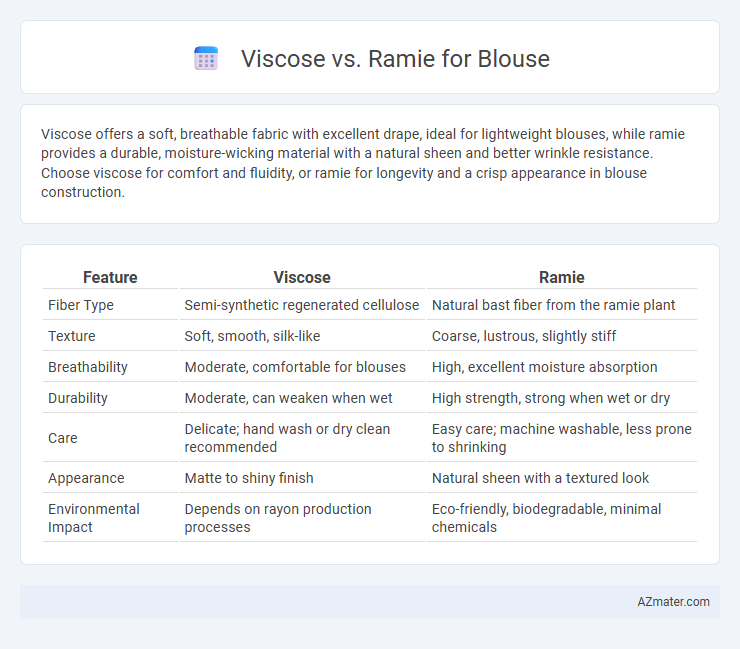Viscose offers a soft, breathable fabric with excellent drape, ideal for lightweight blouses, while ramie provides a durable, moisture-wicking material with a natural sheen and better wrinkle resistance. Choose viscose for comfort and fluidity, or ramie for longevity and a crisp appearance in blouse construction.
Table of Comparison
| Feature | Viscose | Ramie |
|---|---|---|
| Fiber Type | Semi-synthetic regenerated cellulose | Natural bast fiber from the ramie plant |
| Texture | Soft, smooth, silk-like | Coarse, lustrous, slightly stiff |
| Breathability | Moderate, comfortable for blouses | High, excellent moisture absorption |
| Durability | Moderate, can weaken when wet | High strength, strong when wet or dry |
| Care | Delicate; hand wash or dry clean recommended | Easy care; machine washable, less prone to shrinking |
| Appearance | Matte to shiny finish | Natural sheen with a textured look |
| Environmental Impact | Depends on rayon production processes | Eco-friendly, biodegradable, minimal chemicals |
Introduction to Viscose and Ramie Fabrics
Viscose fabric, derived from cellulose fibers, offers a smooth texture and excellent breathability, making it a popular choice for blouses due to its silk-like appearance and comfort. Ramie, a natural fiber extracted from the stalks of the Chinese nettle plant, boasts high durability, moisture-wicking properties, and a crisp texture that resists wrinkles. Both fabrics provide unique qualities ideal for different blouse styles, with viscose favored for softness and drape, and ramie appreciated for strength and a natural luster.
Origins and Production Processes
Viscose, derived from cellulose in wood pulp through a chemical-intensive process, contrasts with ramie, a natural fiber harvested from the stalks of the Ramie plant using mechanical extraction and retting. The viscose production involves dissolving cellulose in chemicals like sodium hydroxide and carbon disulfide, then regenerating fibers through spinning, ensuring a smooth and shiny fabric ideal for blouses. Ramie's production is more labor-intensive, relying on traditional methods of stripping, degumming, and softening to produce a strong, breathable fabric with a natural luster, making it a sustainable alternative in textile manufacturing.
Key Differences in Fiber Composition
Viscose is a semi-synthetic fiber made from chemically processed wood pulp, predominantly cellulose, offering a soft, smooth texture with high absorbency. Ramie is a natural bast fiber derived from the stalks of the Chinese nettle plant, characterized by superior strength, resilience, and a silky luster. The key difference lies in viscose's regenerated cellulose nature which provides excellent drape and breathability, while ramie's natural fiber composition ensures durability and resistance to wrinkles, making each suitable for different blouse fabric preferences.
Texture and Feel: Comfort Comparison
Viscose offers a soft, smooth texture with a silky feel, making it highly breathable and comfortable for blouse wear in warm climates. Ramie fabric has a coarser texture with a crisp hand, providing durability but less softness compared to viscose, which can affect overall comfort against the skin. Choosing viscose enhances comfort through its lightweight and moisture-absorbing properties, whereas ramie excels in strength and wrinkle resistance despite its rougher feel.
Breathability and Moisture Management
Viscose offers excellent breathability due to its semi-synthetic cellulose fibers, allowing air circulation and making it comfortable for blouses in warm weather. Ramie, derived from natural plant fibers, boasts superior moisture-wicking properties, quickly absorbing sweat and drying faster than viscose, which enhances moisture management. Both fabrics provide good ventilation, but ramie's enhanced moisture control makes it ideal for highly humid conditions.
Durability and Longevity
Viscose is a semi-synthetic fiber known for its softness but tends to wear out faster and lose shape after multiple washes, impacting its durability and longevity in blouses. Ramie, a natural bast fiber, offers superior strength and resistance to stretching, making blouses made from ramie more durable and longer-lasting. Choosing ramie over viscose enhances blouse longevity due to its ability to maintain fabric integrity despite frequent use and washing.
Environmental Impact and Sustainability
Viscose production involves chemically intensive processes with significant water consumption and deforestation concerns, raising sustainability challenges despite its biodegradable nature. Ramie, derived from a natural plant fiber, requires fewer chemicals and has a lower environmental footprint, making it a more sustainable option for blouses. Choosing ramie supports eco-friendly fashion due to its renewability and reduced ecological impact compared to viscose.
Care and Maintenance Tips
Viscose blouses require gentle hand washing or machine washing on a delicate cycle with cold water to prevent shrinkage and maintain fabric softness, and should never be wrung or twisted. Ramie blouses benefit from air drying in the shade to avoid fabric stiffness and color fading, and ironing is best done while the fabric is slightly damp to retain smoothness. Both fabrics should be stored away from direct sunlight and harsh chemicals to preserve their appearance and durability over time.
Style and Design Suitability for Blouses
Viscose offers a soft, silky texture ideal for flowy, draped blouse designs that emphasize elegance and comfort. Ramie provides a stiffer, textured feel, lending itself well to more structured, tailored blouse styles that maintain shape and add a natural, rustic aesthetic. Choosing between viscose and ramie depends on the desired blouse silhouette and the balance between softness and durability in design.
Final Verdict: Which Fabric is Best for Blouses?
Viscose offers a soft, breathable texture with excellent drape, making it ideal for blouses that require comfort and fluidity. Ramie provides greater durability and a crisp, natural sheen, perfect for structured blouses with a polished appearance. For everyday wear, viscose is best for softness and flow, while ramie excels in longevity and a refined, wrinkle-resistant finish.

Infographic: Viscose vs Ramie for Blouse
 azmater.com
azmater.com